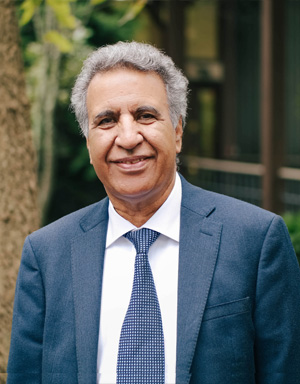International Investing Opportunities
Many U.S. investors stick with stock portfolios because that's natural; because they feel comfortable investing in a company they know something about. However, investing in foreign stocks holds potential to diversify your portfolio. This is a way to take advantage of growth opportunities overseas.
About The Speakers
 Fall Ainina, Ph.D., CFA
Fall Ainina, Ph.D., CFA
Deputy Director of Research / Vice President
Investment Committee Member
 Neil Craft
Neil Craft
Client Relationship Manager
Dr. Fall Ainina: Thank you, Neil.
In the U.S. we have over 29 million cases and 525 thousand deaths. Globally, we have 117 million cases and two and a half million deaths in the U.S. A lot of states are lifting the stay at home orders. They are reopening the businesses and the relaxing social distancing measures. For example, Texas is ending the statewide mask mandate.
States like Florida and South Dakota had been open for a while, and I think because of the vaccine, a lot more states are opening up. Economic growth in the first quarter is expected to rebound. Economists are projecting 10% growth in GDP, which is one of the highest numbers. That's because of government spending and federal reserve easy monetary policy.
Neil Craft: Excellent. Well, thank you for that update. Now let's shift our lens towards the global landscape. How does the recovery look from that standpoint?
Dr. Fall Ainina: Well, economic activity picked up in all major economies in February, but they remained short of the end of the 2020 level.
Internationally the countries that are doing well are the U.S., China, Spain and Israel, and also activities began up in UK and Canada. The global economic collapse into 2020 has been slightly less severe than previously projected, and economies like in China are recovering really fast. Also a disruption of activity in the other major emerging market was less unexpected.
Neil Craft: Okay, well, looking ahead here at the remainder of this year and into 2021, are there any regional economies or even specific countries where we see good opportunities? I know you've mentioned China now a couple of times.
Dr. Fall Ainina: Yeah. China, because China just became the first country to grow with the economy after COVID-19, and the global economy is expected to grow around 4%.
Because of the vaccine, that area, I think, that will do well out of the emerging markets. That's where they have the best growth opportunity. The reason that they have a cheaper stock market, they will benefit from the global economic rebound because they are the main producer of raw materials. Lower interest rates and the weaker dollar usually helps to diminish their economy and perhaps the more trade friendly Biden administration will make it easier for the economy. And the next group, that's probably going to go online out of Europe. They are those that were hardest hit by Corona. And now, it looks like some of them, like Spain and Germany, are opening up because of the vaccine.
Neil Craft: Excellent. So it sounds like there are definitely opportunities out there. How can our investors gain some exposure, I should say, to the International markets?
Dr. Fall Ainina: Many U.S. investors stick with stock portfolios because that's natural; because they feel comfortable in investing in a company they know something about. If you invest in foreign stock, you diversify your portfolio. Also, there are a lot more growth opportunity overseas, because if you look at demographics, most demographic increases are happening overseas.
In general, there are three ways to invest internationally. You can invest directly in foreign stock, and that's what we do at James Investment. We buy ADR American Depository Receipts.
An American Deposit Receipt is basically a receipt on a stock overseas. You can buy Honda stock here in the U.S. but what you are buying is a receipt on the stock that is traded on the Tokyo stock exchange. You can also buy internationally focused, exchange traded fund ETF or mutual funds to gain more of an exposure.
And the third way of doing it is buying shares in the multinational corporations that are based in the U.S. but do almost all their business internationally. Many of the largest U.S.-based multinational corporations have more than two thirds of their total sales outside of the U.S. Take Intel; 80% of Intel sales are overseas. Coca-Cola 70%, Exxon Mobile, 60-65% Apple, 63%. And the list goes on and on. Those are the three ways of doing it. In some markets you can't really buy ADR’s because they are too risky. For example, in emerging markets. Also, people usually use a mutual fund or an exchange traded fund to do it. But for the well-developed, large company, people buy ADR’s.
For example, if we want to buy the stock in Alibaba, that stock is available here, traded in the U.S., a Chinese company.
Neil Craft: Excellent. Excellent. So there are a number of ways to increase your exposure internationally in your portfolio. Some of which, you know, don't necessarily come to mind immediately, but, Fall, thank you so much for these different strategies. And I appreciate your time today and this valuable information.
Dr. Fall Ainina: Thank you, Neil. Thank you very much for giving me the opportunity.
Neil Craft: Again, if you have any questions about international investments or opportunities, please get in touch with us at www.jamesinvestment.com. James Investment: Your Future, Our Purpose.
* Diversification does not eliminate the risk of experiencing investment losses.
Top 10 Holdings - Golden Rainbow
Top 10 Holdings - Small Cap
Top 10 Holdings - Micro Cap
Top 10 Holdings - Aggressive Allocation
Recent Podcasts
Social Security & Cost of Living Adjustment
1st Quarter Update - Economic Outlook 2022
3rd Quarter Update - Economic Outlook 2021
Understanding Risks In Cryptocurrency
2nd Quarter Update - 2021 Economic Outlook
1st Quarter Update - 2021 Economic Outlook
Balanced
Typical Allocation Range
Equity: 40% - 70%
Fixed Income: 30% - 60%
Cash: 1% - 15%
The Balanced strategy has a target range of 40% - 70% in equities, with a mix of small, mid, and large capitalization stocks. We weight the stock exposure toward the most advantageous market capitalizations based on our research.
Sector analysis in an important part of our portfolio management process. Changes in sector weightings are made based on our analysis.
We believe that having the maximum flexibility to follow our research is the key to adding value to our clients' accounts.

